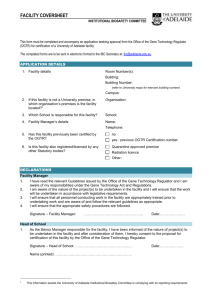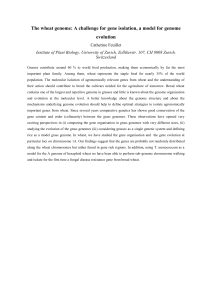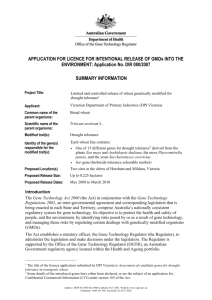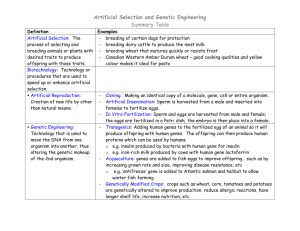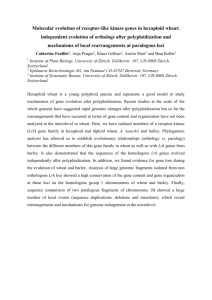DOCX 55 KB
advertisement
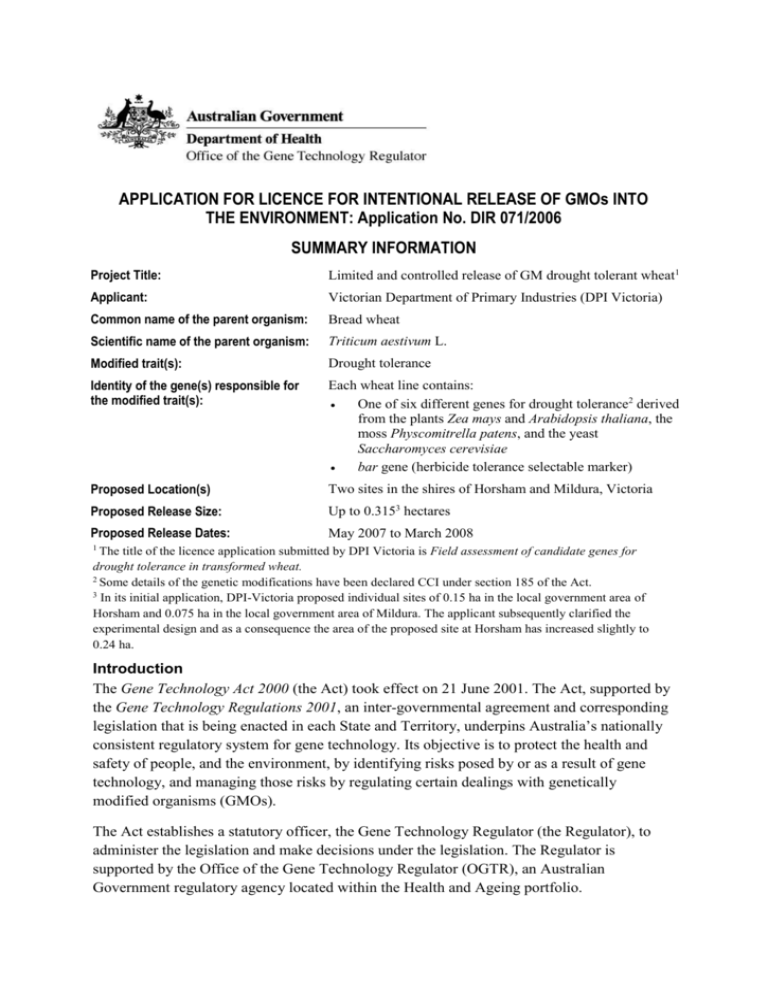
APPLICATION FOR LICENCE FOR INTENTIONAL RELEASE OF GMOs INTO THE ENVIRONMENT: Application No. DIR 071/2006 SUMMARY INFORMATION Project Title: Limited and controlled release of GM drought tolerant wheat1 Applicant: Victorian Department of Primary Industries (DPI Victoria) Common name of the parent organism: Bread wheat Scientific name of the parent organism: Triticum aestivum L. Modified trait(s): Drought tolerance Identity of the gene(s) responsible for the modified trait(s): Each wheat line contains: One of six different genes for drought tolerance2 derived from the plants Zea mays and Arabidopsis thaliana, the moss Physcomitrella patens, and the yeast Saccharomyces cerevisiae bar gene (herbicide tolerance selectable marker) Proposed Location(s) Two sites in the shires of Horsham and Mildura, Victoria Proposed Release Size: Up to 0.3153 hectares Proposed Release Dates: May 2007 to March 2008 1 The title of the licence application submitted by DPI Victoria is Field assessment of candidate genes for drought tolerance in transformed wheat. 2 Some details of the genetic modifications have been declared CCI under section 185 of the Act. 3 In its initial application, DPI-Victoria proposed individual sites of 0.15 ha in the local government area of Horsham and 0.075 ha in the local government area of Mildura. The applicant subsequently clarified the experimental design and as a consequence the area of the proposed site at Horsham has increased slightly to 0.24 ha. Introduction The Gene Technology Act 2000 (the Act) took effect on 21 June 2001. The Act, supported by the Gene Technology Regulations 2001, an inter-governmental agreement and corresponding legislation that is being enacted in each State and Territory, underpins Australia’s nationally consistent regulatory system for gene technology. Its objective is to protect the health and safety of people, and the environment, by identifying risks posed by or as a result of gene technology, and managing those risks by regulating certain dealings with genetically modified organisms (GMOs). The Act establishes a statutory officer, the Gene Technology Regulator (the Regulator), to administer the legislation and make decisions under the legislation. The Regulator is supported by the Office of the Gene Technology Regulator (OGTR), an Australian Government regulatory agency located within the Health and Ageing portfolio. The legislation sets out the requirements for considering applications for licences for dealings with GMOs and the matters that the Regulator must take into account before deciding whether, or not, to issue a licence1. The application and the proposed dealings The OGTR has received an application from the Victorian Department of Primary Industries (DPI Victoria) for a licence for the intentional release of genetically modified (GM) bread wheat (Triticum aestivum L.) into the environment on a limited scale and under controlled conditions. Up to 30 GM wheat lines are proposed to be trialled. Each line contains one of six different genes derived from the plants thale cress (Arabidopsis thaliana) and maize (Zea mays), a moss (Physcomitrella patens) and a yeast (Saccharomyces cerevisiae). The introduced genes encode proteins that are intended to improve drought tolerance by regulating gene expression or modulating biochemical and signal transduction pathways in the wheat plants. The purpose of the trial is to conduct ‘proof of concept’ research to evaluate the agronomic performance, including yield, of the GM wheat lines under rain-fed, drought prone conditions. Seed would also be collected and retained for analysis and possible future trials of lines that may be selected for further development (subject to additional approvals). The release is proposed to take place at two sites, on an area of 0.242 ha in the shire of Horsham and an area of 0.075 ha in the shire of Mildura, over one season (May 2007 – March 2008). Both locations are typical of rain-fed, drought prone wheat production environments in Victoria. DPI Victoria has proposed a number of containment measures for the conduct of the field trial that will be considered during the assessment of the application including: Surrounding the trial sites by a 10 m monitoring zone and a 490 m isolation zone Harvesting of all plant material by hand to minimise GM seed spillage at the sites Destruction after analysis of all harvested GM plant material (except seed) Cleaning of trial sites within 14 days of harvest and incorporating any remaining plant material into the soil to promote decomposition Post harvest monitoring of the trial sites for a period of two years, including irrigation to promote germination of seeds, and destruction of any volunteer plants Storage and transportation of GM seed and plant materials in accordance with OGTR guidelines. 1 More information on the assessment of licence applications and copies of the Risk Analysis Framework are available from the Office of the Gene Technology Regulator (OGTR). Free call 1800 181 030. 2 In its initial application, DPI-Victoria proposed individual sites of 0.15 ha in the local government area of Horsham. The applicant subsequently clarified the experimental design and as a consequence the area of the proposed site at Horsham has increased slightly to 0.24 ha. None of the GM wheat plants from the proposed release, or their by-products, will be used in human food or animal feed. An approval from Food Standards Australia New Zealand would be required before the GM wheat lines could be used in food for human consumption. Confidential Commercial Information Some details including the names and classes of the introduced genes, the names and origins of the promoters (regulatory sequences), and data from previous international field releases of other plants expressing the same genes, have been declared Confidential Commercial Information (CCI) under section 185 of the Act. The confidential information will be made available to the prescribed experts, agencies and authorities that will be consulted on the preparation of the risk assessment and risk management plan for this application. Previous releases of the same or other GMOs The GM wheat lines proposed for release have not been previously released in Australia or overseas. Under the former voluntary system overseen by the Genetic Manipulation Advisory Committee (GMAC), there have been five field trials of different types of GM wheat ranging in size from 325–1500 plants: PR65 (1996), PR66 (1996), PR102 (1998), PR102X (2000), and PR107 (1999). In addition, the Regulator issued licences for the limited and controlled release of two other GM wheat lines: DIR 053/2004 was issued to Grain Biotech for GM salt tolerant wheat on an area of 0.45 ha in Western Australia; and DIR 054/2004 was issued to CSIRO for GM wheat with altered starch content on 0.25 ha in the Australian Capital Territory. There have been no reports of adverse effects on human health or the environment resulting from any of these releases. Parent organism The parent organism is bread wheat (Triticum aestivum L.) cultivar ‘Bobwhite’. Bobwhite is not grown as a commercial bread wheat cultivar but is commonly used in genetic modification work in Australia and overseas. Bread wheat is exotic to Australia. It has been grown here since European settlement in 1788 and is now grown extensively in Australia as a winter crop. Planting of wheat is influenced by soil moisture availability and cultivar type and generally occurs between early April and late June with harvest occurring between late November and late December. Genetic modification and its effect Each GM wheat line contains one of six genes encoding proteins expected to enhance drought tolerance. The genes are derived from the plants Arabidopsis thaliana and Zea mays, the moss Physcomitrella patens and the yeast Saccharomyces cerevisiae. For each gene there are two constructs, one driven by a stress inducible promoter and one by a constitutive promoter, giving a total of 12 different gene constructs used to produce the 30 GM wheat lines. A promoter is a short regulatory sequence that controls the level, timing and location of expression of the protein encoded by a gene. The GM wheat lines also contain the herbicide tolerance gene, bar, isolated from Streptomyces hygroscopicus, which was used as a marker to select for modified plants. The bar gene encodes the phosphinothricin acetyltransferase (PAT) enzyme, which provides tolerance to herbicides containing glufosinate ammonium. The applicant does not intend to apply glufosinate ammonium during the field trial. Additionally, the gene constructs contain the bla gene from Escherichia coli, which confers resistance to the antibiotic ampicillin. This gene was used to select for bacteria containing plasmids3 with the desired genes in the laboratory, prior to the production of the GM plants, and is not expressed in the GM wheat lines as it is linked to a bacterial promoter that does not function in plants. Some of the regulatory sequences that control the expression of the introduced genes in the GM wheat lines are derived from plant pathogens (Agrobacterium tumefaciens and Cauliflower mosaic virus). These regulatory sequences comprise only a small part of their total respective genome and are not capable of causing disease. Method of genetic modification The genes were introduced into bread wheat by particle bombardment. This technique involves coating plasmids containing the gene constructs onto very small gold particles that are ‘shot’ into embryos from wheat, which are then regenerated into whole plants in tissue culture. Particle bombardment has been widely used in Australia and overseas for introducing new genes into plants without causing any biosafety problems. A total of up to 30 lines, derived from 12 gene constructs, are proposed for release. All are the result of independent genetic modification events. Consultation on preparation of the Risk Assessment and Risk Management Plan The Regulator has made an initial assessment as to whether the proposed release may pose significant risks to human health and safety or the environment, in accordance with section 49 of the Act. Due to the characteristics of the introduced genes, the control measures that have been proposed, and the limited scale and scope of the dealings, the Regulator has decided that the proposed release does not pose a significant risk to human health and safety or the environment. This means that the Regulator is not required to seek public comment on the assessment of this proposal until after a risk assessment and risk management plan (RARMP) has been prepared for consultation. In the interim, copies of the application are available on request from the OGTR. Please quote application number DIR 071/2006. In preparing the RARMP, the Regulator will seek input from a wide range of experts, agencies and authorities including State and Territory Governments, Australian Government 3 Naturally occurring circles of DNA that are distinct and separate from the bacterial genome. agencies, the Minister for the Environment and Heritage, the Gene Technology Technical Advisory Committee and relevant local councils. The Regulator will consult again with these key stakeholders and expert groups, as well as the public, in finalising the RARMP, which then forms the basis of her decision whether or not to issue a licence. At this stage, the consultation version of the RARMP is expected to be released for a six week consultation period in early April 2007. The public will be invited to provide submissions on the RARMP via advertisements in the media and direct mail to anyone registered on the OGTR mailing list. The RARMP and other related documents will be available from the OGTR, or on the OGTR website. If you have any questions about the application or the assessment process, please contact the OGTR at: The Office of the Gene Technology Regulator MDP 54 GPO Box 9848 CANBERRA ACT 2601 Tel: 1800 181 030 Fax: 02 6271 4202 Email: ogtr@health.gov.au OGTR Website
